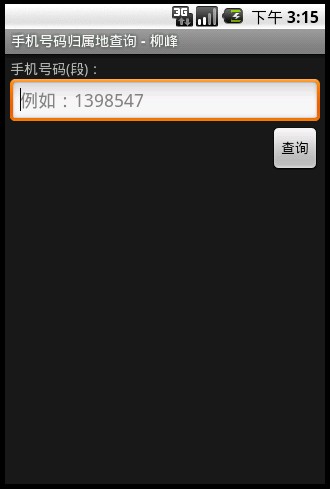本文主要是介绍[017] Android平台HttpClient的使用-手机号码归属地查询 .,希望对大家解决编程问题提供一定的参考价值,需要的开发者们随着小编来一起学习吧!
1) Shared Preferences 一个轻量级的键-值存储机制,专门用于存储键-值对数据,并且仅可以存储基本的数据类型(boolean、int、long、float和String);通常使用它来存储应用程序的配置信息。
2) 文件存储 通过FileInputStream和FileOutputStream对文件进行操作,在Android中,文件是一个应用程序私有的,一个应用程序无法读写其它应用程序的文件。
3) SQLite存储 SQLite是一款轻型的数据库,支持标准SQL。它的设计目标是嵌入式的,占用资源非常的低,在嵌入式设备中,只需要几百K的内存就够了。Android平台也为我们提供了SQLite数据库。
4) 网络存储 以上3种方式数据均存储在手机上,而网络存储的数据是存储在远程服务器上,手机客户端通过联接到网络来存储和获取数据。
今天要讲解的HttpClient正是常用的网络存储工具之一。记得最早接触HttpClient是在两年前,当时要做一个垂直搜索引擎,数据自然是来源于互联网,通过一个爬虫系统不断从指定网站上爬取感兴趣的数据,然后通过Lucene搜索引擎框架实现海量数据的快速检索。而爬虫系统最开始是想采用开源的爬虫框架Heritrix来实现,但接触一段时间后发现Heritrix过于庞大,而且是作为一个独立的系统运行,不方便嵌入到现有的系统中,再加上学习成本高,最后还是选择了“HttpClient + HtmlParser”来实现的小型爬虫系统;其中HttpClient可以模拟HTTP的POST和GET请求,用于从指定网站获取网页数据,而HtmlParser用于解析爬取到的页面,过滤HTML标记,取得最终数据。
是不是发现HttpClient还挺强大的?让我们看看它是什么来头。"HttpClient 是 Apache Jakarta Common 下的子项目,可以用来提供高效的、最新的、功能丰富的支持 HTTP 协议的客户端编程工具包,并且它支持 HTTP 协议最新的版本和建议"。如果你以前没有接触过HttpClient,那么你只需要简单记住两点就可以了:1)HttpClient是一个HTTP协议开发包;2)HttpClient不是Android的专利。
HttpClient的功能介绍:
1)实现了HTTP请求的所有方法(如GET、POST、PUT、HEAD 等);
2)支持自动转向;
3)支持 HTTPS 协议;
4)支持代理服务器等
HttpClient的基本使用(以POST请求为例):
1)创建HttpClient实例(类似于浏览器客户端);
HttpClient client = new DefaultHttpClient();
2)创建HttpPost请求,需要向HttpPost的构造方法传入所请求的URL;
HttpPost post = new HttpPost(requestUrl);
3)发出POST请求(调用HttpClient的execute()方法,execute()的参数为HttpPost实例);
HttpResponse response = client.execute(post);
4)读取返回结果;
5)释放连接;
6)对返回的结果进行处理。
在Android平台上使用HttpClient,并不需要添加额外的jar包,因为Android平台吸收了许多优秀的开源框架,其中就包括HttpClient。(注意我写的是吸收,不是收购,两码事),下面就来看一个Android平台使用HttpClient的例子。
1)首先来看布局文件res/layout/main.xml
- <?xml version="1.0" encoding="utf-8"?>
- <LinearLayout xmlns:android="http://schemas.android.com/apk/res/android"
- android:orientation="vertical"
- android:layout_width="fill_parent"
- android:layout_height="fill_parent"
- android:paddingTop="5dip"
- android:paddingLeft="5dip"
- android:paddingRight="5dip"
- >
- <TextView
- android:layout_width="fill_parent"
- android:layout_height="wrap_content"
- android:text="手机号码(段):"
- />
- <EditText android:id="@+id/phone_sec"
- android:layout_width="fill_parent"
- android:layout_height="wrap_content"
- android:inputType="textPhonetic"
- android:singleLine="true"
- android:hint="例如:1398547"
- />
- <Button android:id="@+id/query_btn"
- android:layout_width="wrap_content"
- android:layout_height="wrap_content"
- android:layout_gravity="right"
- android:text="查询"
- />
- <TextView android:id="@+id/result_text"
- android:layout_width="wrap_content"
- android:layout_height="wrap_content"
- android:layout_gravity="center_horizontal|center_vertical"
- />
- </LinearLayout>
2)Activity的代码
- package com.liufeng.web.activity;
- import java.util.ArrayList;
- import java.util.List;
- import org.apache.http.HttpResponse;
- import org.apache.http.HttpStatus;
- import org.apache.http.NameValuePair;
- import org.apache.http.client.HttpClient;
- import org.apache.http.client.entity.UrlEncodedFormEntity;
- import org.apache.http.client.methods.HttpPost;
- import org.apache.http.impl.client.DefaultHttpClient;
- import org.apache.http.message.BasicNameValuePair;
- import org.apache.http.protocol.HTTP;
- import org.apache.http.util.EntityUtils;
- import android.app.Activity;
- import android.os.Bundle;
- import android.view.View;
- import android.view.View.OnClickListener;
- import android.widget.Button;
- import android.widget.EditText;
- import android.widget.TextView;
- /**
- * HttpClient运用之手机号码归属地查询
- *
- * @author liuyq
- * @date 2011-05-11
- */
- public class MainActivity extends Activity {
- private EditText phoneSecEditText;
- private TextView resultView;
- private Button queryButton;
- @Override
- public void onCreate(Bundle savedInstanceState) {
- super.onCreate(savedInstanceState);
- setContentView(R.layout.main);
- phoneSecEditText = (EditText) findViewById(R.id.phone_sec);
- resultView = (TextView) findViewById(R.id.result_text);
- queryButton = (Button) findViewById(R.id.query_btn);
- queryButton.setOnClickListener(new OnClickListener() {
- @Override
- public void onClick(View v) {
- // 手机号码(段)
- String phoneSec = phoneSecEditText.getText().toString().trim();
- // 简单判断用户输入的手机号码(段)是否合法
- if ("".equals(phoneSec) || phoneSec.length() < 7) {
- // 给出错误提示
- phoneSecEditText.setError("您输入的手机号码(段)有误!");
- phoneSecEditText.requestFocus();
- // 将显示查询结果的TextView清空
- resultView.setText("");
- return;
- }
- // 查询手机号码(段)信息
- getRemoteInfo(phoneSec);
- }
- });
- }
- /**
- * 手机号段归属地查询
- *
- * @param phoneSec 手机号段
- */
- public void getRemoteInfo(String phoneSec) {
- // 定义待请求的URL
- String requestUrl = "http://webservice.webxml.com.cn/WebServices/MobileCodeWS.asmx/getMobileCodeInfo";
- // 创建HttpClient实例
- HttpClient client = new DefaultHttpClient();
- // 根据URL创建HttpPost实例
- HttpPost post = new HttpPost(requestUrl);
- List<NameValuePair> params = new ArrayList<NameValuePair>();
- // 设置需要传递的参数
- params.add(new BasicNameValuePair("mobileCode", phoneSec));
- params.add(new BasicNameValuePair("userId", ""));
- try {
- // 设置URL编码
- post.setEntity(new UrlEncodedFormEntity(params, HTTP.UTF_8));
- // 发送请求并获取反馈
- HttpResponse response = client.execute(post);
- // 判断请求是否成功处理
- if (response.getStatusLine().getStatusCode() == HttpStatus.SC_OK) {
- // 解析返回的内容
- String result = EntityUtils.toString(response.getEntity());
- // 将查询结果经过解析后显示在TextView中
- resultView.setText(filterHtml(result));
- }
- } catch (Exception e) {
- e.printStackTrace();
- }
- }
- /**
- * 使用正则表达式过滤HTML标记
- *
- * @param source 待过滤内容
- * @return
- */
- private String filterHtml(String source) {
- if(null == source){
- return "";
- }
- return source.replaceAll("</?[^>]+>","").trim();
- }
- }
3)在AndroidManifest.xml中添加访问网络的权限
- <uses-permission android:name="android.permission.INTERNET" />
4)运行结果截图


备注:是不是发现HttpClient很容易使用呢?其实,上面所讲解的只是HttpClient最基本的功能(发起POST请求);我们在浏览器客户端所执行的大多数操作HttpClient都能够模拟,例如:提交表单、查询数据、上传下载文档、页面跳转、Session存储等。比如大家经常玩“抢车位”、“偷菜”,就可以通过HttpClient编程自动实现。(其实这就相当于外挂的原型了,尝试一下可以,小心被封号!)
这篇关于[017] Android平台HttpClient的使用-手机号码归属地查询 .的文章就介绍到这儿,希望我们推荐的文章对编程师们有所帮助!






